Box Tree Moth Quarantine in DE and PA
Happy New Year, everybody! Hope y’all enjoyed your holidays as much as I did.
In this issue, I’ll catch up on a few pieces of news I missed in 2024 and get ready for a wonderful 2025 by first cleaning things up!
The first piece of news to catch up on is about box tree moth (BTM).
USDA-APHIS announced on December 4, 2024, that it has placed the entire state of Delaware and Erie County, Pennsylvania, under quarantine for BTM. (Go HERE for USDA-APHIS’s notification on the quarantine action.) Delaware and Erie County now join the unfortunate part of the quarantine areas, which previously included counties in southeastern Michigan, southwestern Ohio, western New York and the entire state of Massachusetts.
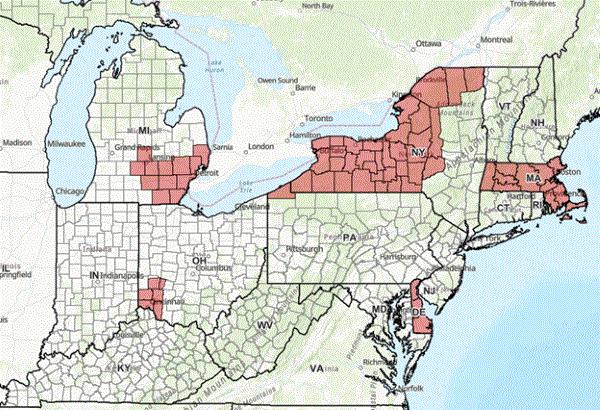
Counties under active BTM quarantine are colored. (Map from USDA-APHIS.)
The first detection of this devastating caterpillar pest in Delaware was made on July 11, 2024, and in Pennsylvania on August 29, 2024. Both infestations were in residential or commercial landscapes. As far as I know, infestation hasn’t been found in nurseries.
Interstate movement of boxwood materials from the quarantined areas will be regulated under a compliance agreement among growers, distributors, USDA-APHIS and state departments of agriculture. If you LOVE legalese, go HERE for the order of quarantine in Pennsylvania. For something a bit more straightforward, go HERE for a webinar recording from the Horticultural Research Institute (HRI) entitled “Box Tree Moth Compliance Agreement Explained.”
Extension at Penn State University and other states are pretty proactive at developing good resources on identifying and managing BTM since its very first detection in plant shipments and landscapes in 2021. Michael Skvarla and Patricia Prade, both at Penn State, wrote a fact sheet (with great pictures) and a management guide on BTM, respectively.
For something a bit more science-y and co-authored by yours truly, go HERE for a review of the biology, ecology and management of BTM. And, finally, go HERE for an HRI webinar recording on the most recent research on BTM biology and management given by Joe Boggs of The Ohio State University and Alejandro Del-Pozo of Virginia Tech.

Introducing Entrapment Insecticide
Attune Agriculture introduced its new Entrapment insecticide in early December. Well, Entrapment isn’t one product, but a line of products registered for different crop systems. Entrapment SP is registered for specialty crops, turf and ornamentals; FV for fruits and vegetables; RC for row crops; and CK for caterpillar killer (you get the idea). Go HERE to see all the formulations and information on Entrapment.
All formulations contain 0.15% xanthan gum. Does xanthan gum sound familiar? Yes, you’d seen xanthan gum on the ingredients list of your store-bought salad dressing or the egg substitute you had for breakfast. Xanthan gum is widely used as a stabilizer and thickener in foods, but it also has a lot of other industrial uses. (I’m sure the xanthan gum in Entrapment isn’t the exact same thing you ate last night.) Attune has formulated xanthan gum to make it function as an insecticide; Attune calls it Rhexalloid technology.
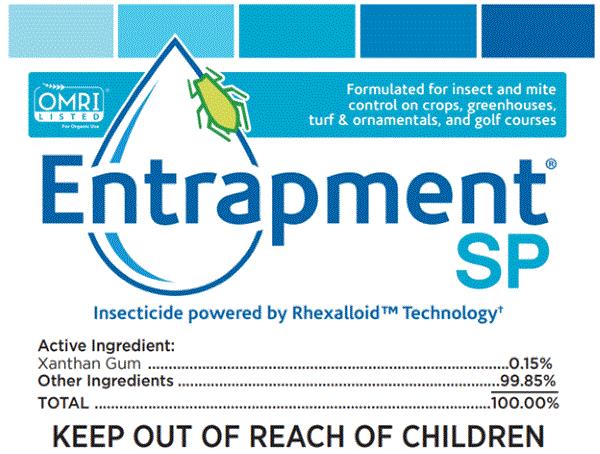
I’m going to look closely at the Entrapment SP label since we’re most concerned with ornamentals and specialty crops. Entrapment SP is OMRI-listed and doesn’t have a signal word. (It does tell you to keep this product out of reach of children.) It has a four-hour REI (restricted entry interval), zero-day PHI (post-harvest interval) and pretty standard PPE requirements. No need for respirator during mixing, applying or entering the greenhouse before the REI expires.
This product has been registered for controlling aphids, young caterpillars, leafhoppers, psyllids, soft and armored scales, flea beetles, thrips, whiteflies, (spider, broad, cyclamen and eriophyid) mites, and true bugs when diluted to 0.0625% to 0.5% (or 8 to 64 fl. oz. per 100 gallons). Each pest group has a specific application rate; go HERE for the label of Entrapment SP.
So how does Entrapment work? According to Attune, Entrapment is a non-systemic, contact insecticide that works in three ways. Small insects and mites are engulfed by spray droplets and suffocated. Slightly larger insects are trapped and immobilized by the droplets. Even larger insects may break free from the droplets, but debris can stick to their now sticky cuticles and immobilize them. Go HERE to see a video explaining these physical modes of action with dead cartoon mites, thrips and aphids.
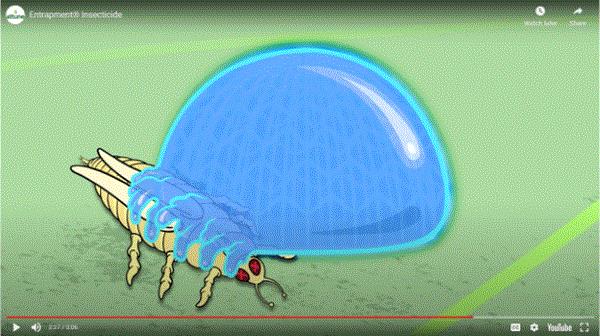
This is how Entrapment insecticide makes a pesky thrips into a good thrips. (Image from Attune Agriculture.)
The risk of resistance development against Entrapment is low because of the physical mode of action explained above. Entrapment is also claimed to be soft on beneficials and doesn’t cause phytotoxicity. It can be used alone or in tank mixed with other insecticides, fungicides, fertilizers and plant growth regulators. But don’t mix Entrapment with other adjuvants or surfactants (except for Attune’s own Ampersand adjuvant). When used in a tank mix, Entrapment should be added to the tank before other products. Jugs of Entrapment should be kept above 50F and avoid freezing.
How effective is Entrapment? I don’t have any personal experience since I haven’t worked with this product. Go HERE for trial reports from Attune.

How Do You Kill Weed Seeds on a Stake?
One last loose end to tie up ...
Remember I asked y’all how to kill weed seeds that were stuck to irrigation stakes in the early October issue of this newsletter? I asked for your help because I really didn’t know what to recommend, especially when the grower didn’t really want to detach the stakes and treat them.
All I know is I’m not aware of any post- or preemergence herbicide that will do the job of killing the seeds or preventing them from germinating. The grower could do a really good preemergence treatment after inserting the stakes, but I think he'll still be sorely disappointed by the efficacy.
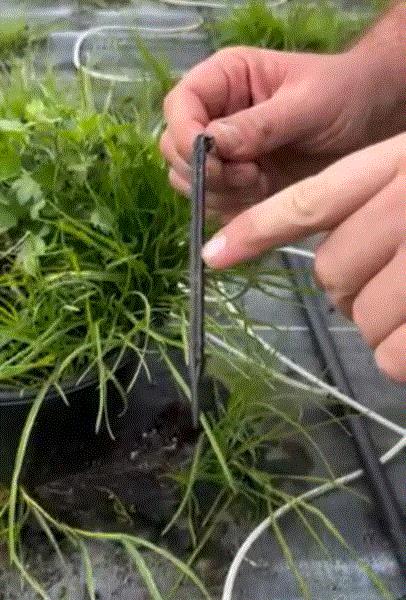
A couple of folks shared with me their experience in treating trays for diseases, not stakes for weed seeds. But I feel like the approach may be usable for both diseases and weed seeds. I want to share their experiences here, even if it’s been three months since the call for help had gone out.
Both landed on the idea of steaming the stakes, but none of us are entirely sure of the precise temperature to use. One directed me to William Jarvis’ "Managing Diseases in Greenhouse Crops," which has a table on thermal inactivation of selected plant pathogens and pests (page 91). The table indicates that weed seeds are inactivated between 158F and 176F (70C to 80C) for 15 minutes. The other contributor suggested steaming for 60 minutes at 150F to 160F (65C to 71C) and added that submerging Styrofoam trays in 190F hot water for a full minute also seems to work for some foresters.
Can the irrigation stakes stand the high heat? Can steam treatment be effective? I don’t know, so I’m still looking for a few wise people who’re willing to share their experience in 2025. Reach out to me by email.

Spring Sanitation
Hopefully, everyone has great and profitable crops in 2024. Now that poinsettias and fall pansies are out and spring crops haven’t flooded in, let’s think about cleaning up our workspaces to start the new year right.
I talked about between-crop sanitation in the January 2024 issue of this newsletter, but I want to revisit this important task here. After all, as our very own Paul Pilon says, “A good, clean start = A strong finish.” (Go HERE for one of Paul’s articles on sanitation.)
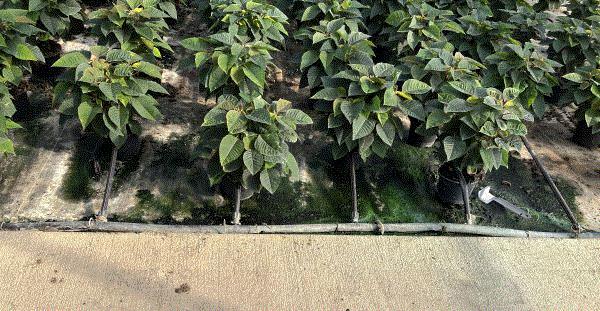
Let’s think about the process in very general terms. First, you want to scrub and brush to remove or strip all the algae, debris, weeds, dead plants or plant parts, old media, etc. This should be done for all benches and hard surfaces, especially if these surfaces are wooden. Don’t forget your irrigation line, heads and stakes that may be covered with algae and all kinds of crud.
After or in conjunction with scrubbing, you want to clean with a cleaner or detergent. Often you want to let the solution sit for a bit so it can loosen up some tough debris or stains. Then you rinse off the surfaces and apply a sanitizer or a disinfectant. There are many sanitizers and disinfectants available, many of them containing quaternary ammonium, hydrogen peroxide, and peracetic or peroxyacetic acid. These sanitizers and disinfectants typically work better with longer contact time, so let the solution sit for a bit. You can also increase contact time by applying the product in thick foam.
Spring sanitation is important, but keeping the propagation and growing areas clean in an organized and systematic fashion is also paramount for the rest of the season. It may seem like a lot of work, but starting clean can prevent problems that may take multiple applications of insecticides, fungicides, algicides or herbicides to solve. Sometimes, these management attempts fail and the crops end up in the Dumpster. Let’s prevent that from happening.





Happy New Year! See y'all later!

JC Chong
Technical Development Manager at SePRO
Adjunct Professor at Clemson University
This e-mail received by 27,847 subscribers like you!
If you're interested in advertising on PestTalks contact Kim Brown ASAP!